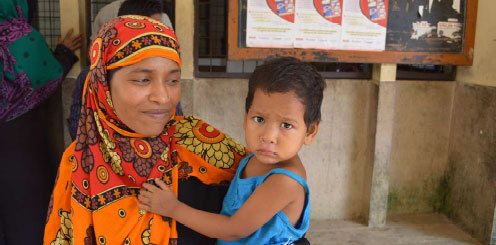QuanTB Helps Ensure Medicines Availability, Averts Waste, and Saves Money in Bangladesh
QuanTB Helps Ensure Medicines Availability, Averts Waste, and Saves Money in Bangladesh

Curbing the spread of tuberculosis (TB) requires that patients have uninterrupted access to a full course of treatment—frequently a difficult task in developing country settings considering that each regimen includes multiple medicines taken over the span of several months. These may need to be customized based on the type of TB being treated and the patient’s reaction to the prescribed combination. The emergence of multidrug-resistant TB (MDRTB) and extensively drug-resistant TB (XDRTB) further complicates the management of TB medicines. Patients with these infections require second-line treatments, which must be taken for a longer duration and have more side effects than first-line treatments. .
Ensuring that TB medicines are available to use when and where they are needed requires strong systems that promote effective medicines management. From forecasting and procurement, to distribution and stock monitoring, these activities often involve extensive planning, complex analyses, and close coordination between health facilities, ministries of health, and suppliers like the Global Drug Facility. In Bangladesh, the US Agency for International Development (USAID)-funded and Management Sciences for Health (MSH)-led Systems for Improved Access to Pharmaceuticals and Services (SIAPS) Program is working with the National Tuberculosis Program (NTP) to strengthen the management of TB medicines, project future needs, and build capacity to ensure that TB medicines are readily available to those who need them.
Partnering to Improve Supply Monitoring and Planning
Recognizing the importance of effective medicines management in decreasing TB incidence, the NTP, with support from SIAPS, formed a national Procurement and Supply Management (PSM) unit to ensure accurate forecasting, timely procurement, and effective stock management of TB medicines across a multidisciplinary group of partners, including the NTP, SIAPS, the World Health Organization, the TB Care II project, the Damien Foundation, and BRAC.
In March 2014, the PSM unit began using the SIAPS-developed QuanTB tool to quantify the projected amount of TB medicines that would be required for the upcoming year. QuanTB is an electronic forecasting, quantification, and early warning tool designed to improve procurement processes, ordering, and planning for TB treatment. QuanTB, a tool which can be downloaded to any desktop, can help program managers quickly calculate forecasting needs and share key information such as actual versus planned consumption, potential stock out scenarios, and upcoming expiries through a user-friendly dashboard.
The initial forecasting exercise, which captured, collated, and analyzed multiple triangulated sources of data, and reassessed previous forecasting assumptions, ultimately yielded better estimates of the number of anticipated TB cases and how many medicines would be required.
Specifically, the quantification exercise conducted using QuanTB indicated two important findings. The first was that current stock levels for first-line TB drugs were at risk for a potential stock-out which could have prevented approximately 1,000 patients from receiving their medicines. In contrast, the second finding indicated that previous procurement assumptions and unanticipated variations in the number of patients started on treatment had resulted in an overstock of medicines typically used to treat extensively drug-resistant TB. The exercise also indicated that several overstocked medicines were set to expire in the coming months.
From Analysis to Action: Data driven decision-making improves management of TB medicines
With QuanTB acting as an early warning system signaling potential stock management issues, the NTP, with technical support from SIAPS, was able to assess these issues and take immediate steps to ensure continued availability of TB medicines while eliminating unnecessary medicines waste.
To address the potential stock-out of first-line TB medicines, the NTP worked with the Global Drug Facility to expedite several previously placed orders to ensure that current patients could continue their treatments uninterrupted and that enough supplies were available for new patients.
The NTP team was also able to minimize the extent of overstocked second-line medicines by cancelling, deferring, and reallocating upcoming orders. Over 1.5 million doses of second-line TB medicines were cancelled and over a million doses were reallocated to other countries in the region, saving the NTP $899,976.
SIAPS assisted the NTP in addressing the excess of second-line TB medicines already in-country by using a QuanTB feature that allows for the development of several alternate treatment regimens within existing standard treatment guidelines. By quickly carrying out complex dosing calculations, QuanTB helped to determine that the second-line medicines, originally intended for treatment of XDR-TB patients, could be used for MDR-TB patients. This would allow the NTP to use up the excess stock before is expiration date, while also ensuring that enough stock remains to treat current and expected XDR-TB patients.
Partnership and Planning for Stronger Pharmaceutical Management in the Long Term
The NTP, along with relevant stakeholders and support from SIAPS, is now reviewing procurement data for TB medicines on a regular basis and addresses any issues through the PSM platform. Through increased collaboration and use of reliable data for informed decision making, the NTP now has an early warning mechanism in place that can monitor and track existing stock levels, alert key stakeholders to potential stock-outs and expiries, and improve the availability of medicines for TB patients in Bangladesh.